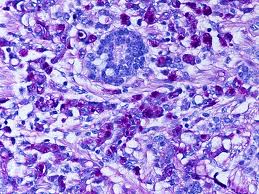Any kind of cancer is a very complicated thing to deal with. These days, with the heightened levels of chemicals and toxins, various kinds of cancer are already manifesting themselves in people from all walks of life, at any age. One such cancer is neuroendocrine cancer.
The neuroendocrine system is the target of neuroendocrine cancer. It originates from the nerve cells and those cells that produce hormones (endocrine cells). There are neuroendocrine cells found in the entire body. Â These specialized cells regulate the circulation of blood in the lungs and the flow of the food during digestion.
There are several neuroendocrine cancer—neuroendocrine carcinoma, endocrine tumors, islet cell tumors, thyroid cancer, thymoma, carcinoid tumors, pheochromocytoma, and Merkel cell cancer. Neuroendocrine carcinoma is a specific type of neuroendocrine cancer. This is a cancer that is found in the brain, GI tract (gastrointestinal tract), and lungs. Pheochromocytoma is a neuroendocrine cancer that targets the chromaffin cells that release adrenaline when your body is stressed. It occurs in the adrenal medulla in the adrenal glands, which are superior to the kidneys. When you have pheochromocytoma, it is very life threatening because of the increased levels of noradrenaline and adrenaline in the blood. Merkel cell cancer is a neuroendocrine cancer that is classified as a trabular cancer. It is very rare and very aggressive. This cancer originates from the cells that produce hormones located in the follicles of the hair and underneath the skin, in the neck and head areas. Given are some of the important facts that you should be familiar with about neuroendocrine cancer in general:
1. Survival rates
 The survival rate for neuroendocrine cancer depends on what kind you are diagnosed with. In pheochromocytoma, the survival rate of at least five years differs from person to person. There is 63 percent survival rate for Merkel cell cancer patients. The progress of every type of neuroendocrine cancer differs from patient to patient. It is really impossible to determine how long the patient still has when the diagnosis is made.
The survival rate for neuroendocrine cancer depends on what kind you are diagnosed with. In pheochromocytoma, the survival rate of at least five years differs from person to person. There is 63 percent survival rate for Merkel cell cancer patients. The progress of every type of neuroendocrine cancer differs from patient to patient. It is really impossible to determine how long the patient still has when the diagnosis is made.
2. Risk factors
 The following are some of the risk factors of neuroendocrine cancer that your doctor will discuss with you upon consultation:
The following are some of the risk factors of neuroendocrine cancer that your doctor will discuss with you upon consultation:
- Age
It is common for people aged seventy to be diagnosed with Merkel cell cancer. Those who have pheochromocytoma are usually 40 to 60 years of age.
- Gender
It is more frequent for men to acquire Merkel cell cancer and pheonhromocytoma.
- Ethnicity
It is highly possible for Caucasians to acquire Merkel cell cancer.
- Family history
Type II MEN (multiple endocrine neoplasia) is a hereditary neuroendocrine cancer related to the pheochromocytoma and medullary thyroid cancer. Type I MEN is also hereditary and makes it more possible for the patient to develop the neuroendocrine cancer in the pancreas, parathyroid gland, and the pituitary gland.
- Suppressed immunity
If the patient has lowered immunity or suppressed immunity like those who are diagnosed with AIDS (acquired immune deficiency syndrome) or HIV (human immunodeficiency virus are more at risk of acquiring neuroendocrine cancer.
- Exposure to arsenic
Merkel cell cancer can be acquired from exposure to heavy amounts of arsenic.
- Exposure to sunlight
The head and the neck areas are exposed to the sun more frequently. With this, it is known for Merkel cell cancer to occur in these areas.
3. Symptoms
 Some symptoms of the various types of neuroendocrine cancer are:
Some symptoms of the various types of neuroendocrine cancer are:
- Merkel cell cancer patients have lumps on the skin that are firm, painless, and can have blue, pink, and red  coloration.
- Pheochromocytoma patients have sweating, headaches, anxiety attacks, elevated blood pressure, fever, palpitations, nausea, tachycardia, clammy skin, and vomiting.
- Neuroendocrine carcinoma patients have diarrhea, pain, high sugar levels, low sugar levels, jaundice, coughs, appetite loss leading to weight loss, change in urination and bowel movement frequency, lump in any body part, anxiety, unexplained bleeding, headaches, gastric ulcer, night sweats, deficiencies, and rashes.
4. Diagnosis
 To correctly diagnose a patient with neuroendocrine cancer, specific diagnostic tests should be done. Blood and urine tests, MRI, CT-scan, and X-rays will be performed on the patient. The doctor will determine the medical condition and the age of the patient; the type of neuroendocrine cancer; the past results obtained; and the level of severity.
To correctly diagnose a patient with neuroendocrine cancer, specific diagnostic tests should be done. Blood and urine tests, MRI, CT-scan, and X-rays will be performed on the patient. The doctor will determine the medical condition and the age of the patient; the type of neuroendocrine cancer; the past results obtained; and the level of severity.
5. Treatment
 Treatments for neuroendocrine cancer are surgery, radiation therapy, and chemotherapy. In surgery (specifically, laparoscopic surgery), the tumor (with some healthy cells along the margin) will be manually removed by a skilled and licensed surgeon. This procedure is done for Merkel cell cancer and pheochromocytoma patients. Radiation therapy uses high level energy particles such as x-ray to eliminate the neuroendocrine cancer cells. Chemotherapy uses anti-cancer drugs to kill the neuroendocrine cancer cells.
Treatments for neuroendocrine cancer are surgery, radiation therapy, and chemotherapy. In surgery (specifically, laparoscopic surgery), the tumor (with some healthy cells along the margin) will be manually removed by a skilled and licensed surgeon. This procedure is done for Merkel cell cancer and pheochromocytoma patients. Radiation therapy uses high level energy particles such as x-ray to eliminate the neuroendocrine cancer cells. Chemotherapy uses anti-cancer drugs to kill the neuroendocrine cancer cells.
If you have undergone treatment for neuroendocrine cancer, you should still coordinate with your oncologist to develop a care plan that follows your treatment plan. Doing so will subject you to frequent physical examinations and tests to keep an eye on your progress.
